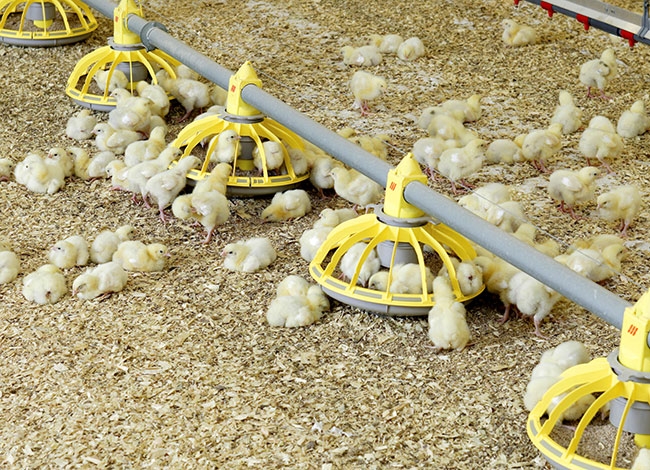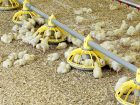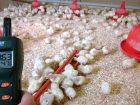
Brooding: Strong out of the gate
By Treena Hein
Features Broilers Production Poultry Production ProductionBrooding best practices and common pitfalls for broiler chicks and turkey poults.
 At the very start, the closer you monitor your chicks the better. PHOTO CREDIT: Cobb
At the very start, the closer you monitor your chicks the better. PHOTO CREDIT: CobbIn livestock farming – or really, in any complex endeavour – a good start is critical. With raising broilers, deficiencies in starting care have often been overlooked in years past for several reasons, according to Dr. Stewart Ritchie, a poultry veterinarian and owner of Canadian Poultry Consultants and S. J. Ritchie Research Farms Ltd. in Abbotsford, B.C.
He notes that while advances in broiler genetics, automated management, precision nutrition and more have resulted in continuous and significant improvements in production efficiencies, the specific requirements of chicks are still numerous, and the negative impacts associated with deficiencies in brooding care are significant. “The genetic potential of modern poultry cannot be achieved,” he says, “without strict attention to brooding.”
Deficiencies in brood management, in Ritchie’s view, can be a barrier to achieving everything from body weight targets, feed utilization and flock health to flock
uniformity, meat yield and reducing the incidence and severity of disease. “Brooding is so critical,” Ritchie explains, “that detailed brooding programs have been developed and we developed our own program called Platinum Brooding that we started offering to our clients as a class in early 2001. It is focused on the establishment of accurate measurements and the thorough, accurate and precise completion of a checklist, and a constant review of progress through the use of the platinum brooding app and dashboard reports. It is a very disciplined approach that works.”
Over the last 16 years, the Platinum Brooding class evolved into a formal education program, and includes presenting experts from companies and institutions such as Phibro Animal Health, Aviagen North America, IDEXX, CEVA, Royal DSM, Big Dutchman and others. Courses and presentations are held at various locations across North America (recently in Cambridge, Ont. and the Annapolis Valley in Nova Scotia) and throughout Australia. Indeed, the BC Chicken Marketing Board and the BC Broiler Hatching Egg Commission have mandated completion of the program as a new grower entry requirement. It is also part of the Aviagen International Production School in Alabama (past nine years), and part of courses/programs at the University of Georgia and the University of Arkansas.
With regard to good brooding, Ritchie notes that factors in place before chick delivery (downtime, cleaning water lines, pre-warming of barn, correct layout of heaters, feeders and drinkers) and after chick delivery are both critical for success. “There should be a focus before and after chick arrival in measuring moisture, temperature and other metrics to achieve a comfort zone,” he explains. “We want good early feed uptake in the first 24 hours, and the establishment of steady state eating patterns. The digestive tract of a chick is very short and anything that disrupts eating patterns is a problem. Many of these management metrics are critical as well for the prevention of coccidiosis.”
At the very start, Ritchie advises that chicks be watched very closely – the more the better. “I find that producers are doing a much better job of monitoring CO2 levels, especially in the winter, and in general, chicks are being watched well to avoid chilling and overheating,” he notes. “Do your measurements and make sure they are on target and make sure you are double-checking your readings and that your instruments are working correctly.”
The new broiler genetics are so good, he concludes, that farmers must now look after their birds like never before. “With using less or no antibiotics, management is now more important as well,” he says. “I think producers are doing very well. We have learned a lot from successful turkey, leghorn and broiler-breeder brooding programs. It’s a huge topic and we have all come a long way. Nothing is broken – we just have a lot of fine-tuning to do. I find producers are open to trying things, are very enthused and are very responsive to instruction.”
Broiler brooding basics
Before chick delivery: Ensure proper downtime has been respected, water lines are pristine, barn has been pre-warmed and layout of heaters, feeders and drinkers is optimized
After chick delivery: Close monitoring and promotion of good early feed uptake in the first 24 hours is critical to establish steady state eating patterns.
Before and after chick arrival: The Platinum Brooding program promotes the establishment of accurate measurements and the thorough, accurate and precise completion of a checklist (in measuring moisture, temperature and other metrics to achieve a comfort zone). It also encourages a constant review of progress through the use of the app and dashboard reports.
Turkeys
Excellent turkey poult care – and long-term performance success – also relates to conditions that should be in place both before and after poult delivery. According to William Alexander, all the factors of importance before poult arrival (adequate downtime, clean water lines, pre-warming, correct layout of heaters, feeders and drinkers) are equally important. “I would say that at this time of year, it’s particularly important to pre-heat the brooder house,” explains the technical service representative with Kitchener, Ont.-based Hybrid Turkeys.
“During the first days of life, a poult’s thermoregulatory system is not yet fully developed, so it depends heavily on the environment to maintain its body temperature.” Alexander strongly advises checking the temperature of the floor, not just the air, prior to poult arrival. “By doing this, you will get a clear indication of what the poults will feel, rather than what you feel,” he explains. “A water sanitation program is also important, and begins with clean water lines before the poults enter the farm.”
After poult delivery, ventilation is one of the most complex areas to manage, according to Alexander. “There are many variable factors on each barn, including number of fans, number of heaters, type of heaters, number of inlets and number of birds,” he explains. “All these factors can impact the air quality. The first step towards excellent air quality is to begin monitoring things like gases and humidity, in addition to temperature. Once you know the conditions you are dealing with, then you can begin looking into what may be causing them to be outside the recommended levels, and then you can seek to resolve and improve those areas.” He’s found that providing optimal air quality not only protects flock health, but can also save growers money in heating costs.
As far as evaluating the comfort level of poults, there are several ways to do it and these are generally categorized into direct and indirect observations. “Indirect observation means you watch the bird’s behaviour,” Alexander explains. “This is a useful method if you have a clear understanding of what is good versus undesirable behaviour – huddling versus spread out or noisy versus quiet, for example. Another indirect evaluation is to check that the crop of the bird is almost full the morning after placement. This shows that they are eating. Poults will only seek out food when they are at the right temperature and comfort level. This understanding of poult behaviour differences comes with time and experience.”
However, indirect observations are not definitive. Alexander believes the only way to be sure how poults are doing is through measuring vent temperatures. Indeed, he recommends it as a best practice for all growers to be used during the brooding phase regardless of whether there are any perceived problems. However, he notes that training is required to both achieve a proper measurement technique and ensure no harm or discomfort is felt by the poult.
Alexander thinks most turkey producers understand the importance of these recommendations, but acknowledges that paying attention to things like water sanitation, humidity and gases are newer developments in poultry production. In the past, he says, turkey farmers tended to use medication if there was a problem, but as producers aim to lessen or eliminate the use of medication, they must focus on using proactive management techniques.
In his view, a proper environment will result in comfortable birds with a desirable internal temperature, birds that will naturally seek out food and water. As with broiler chicks, getting them eating well is critical for long-term health and excellent performance. Alexander concludes that there is no one magic brooding solution that can be applied to all farms, but that “success depends on hard work and dedication to all the little details before, during and after poult placement.”
Poult brooding basics
Before poult delivery: Ensure proper downtime has been respected, water lines are pristine, barn has been pre-warmed and layout of heaters, feeders and drinkers is optimized. Also, check the air temperature at floor level to ensure the proper temperature is being achieved.
After poult delivery: Closely monitor gas, temperature and humidity levels. Ensure poults are eating by maintaining ideal environmental conditions, observing overall behaviour, checking the crop and checking vent temperatures.
Print this page

